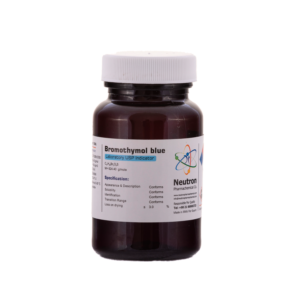Bromocrosol green
| Formula | C21H14Br4O5S |
| Molar mass | 698.05 g/mol |
| CAS number | 76-60-8 |
| HS code | 29349990 |
| EC number | 200-972-8 |
| Storage | Without limitation |
| SDS | Available |
| Description | Conforms | ||
| Identification | Conforms | ||
| Loss on drying ( 110.0 °C ) | ≤ | 3 | % |
| Appearance of solution | Conforms | ||
| Sensitivity test | Conforms | ||
| Transition Range | Conforms |
Bromocresol Green (BCG) is a dye belonging to the triphenylmethane (triarylmethane) family and the sulfonephthalein class of pH indicators. It is widely used in analytical chemistry, clinical diagnostics, and microbiological research.
🏭⚗️ Chemical Properties
• In aqueous solution, BCG exists in different ionic forms depending on the pH. It first ionizes to form a monoanionic yellow form, and at higher pH values, it further deprotonates to form a dianionic blue form, stabilized by resonance.
• These two forms exhibit an isosbestic point in their UV-Visible absorption spectrum around 515 nm, indicating direct interconversion between them without the formation of intermediate species.
• A 0.04 wt% solution of BCG in ethanol is commonly used as a TLC staining reagent, especially for detecting acidic functional groups (e.g., carboxylic and sulfonic acids with pKa < 5.0). These compounds appear as yellow spots against a light or dark blue background. No heating is required.
• BCG is synthesized through the bromination of cresol purple (m-cresolsulfonphthalein).
🧪 Applications
• pH Indicator: Used in titrations and buffer systems due to its sharp color transition from yellow (pH < 3.8) to blue (pH > 5.4).
• Clinical Diagnostics: Commonly used to measure serum albumin levels in blood samples, particularly in cases of liver disease or kidney failure.
• TLC Staining: Useful for visualizing acidic compounds in thin-layer chromatography.
• Electrophoresis Tracking Dye: Occasionally used as a tracking dye in agarose gel electrophoresis of DNA.
• Other Uses:
o Acts as an inhibitor of prostaglandin E2 transport protein.
o Employed in sol-gel matrix systems.
o Serves as a reagent for ammonia detection.
BCG is available in two main forms:
• Free acid form: Light brown solid
• Sodium salt: Dark green solid
⚠️ Safety
• BCG may cause skin and eye irritation.
• Avoid direct contact and inhalation.
• Use appropriate personal protective equipment (PPE) when handling.





